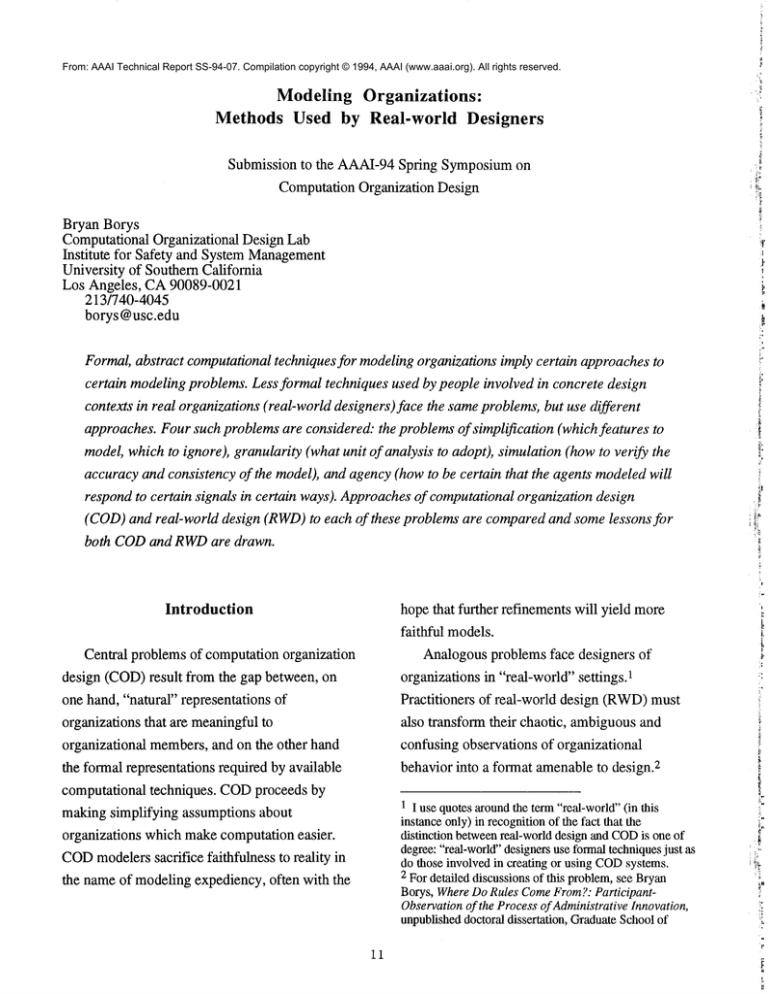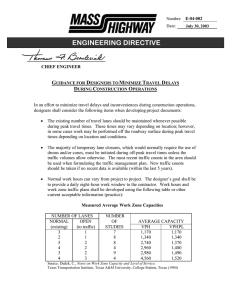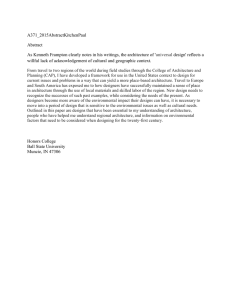
From: AAAI Technical Report SS-94-07. Compilation copyright © 1994, AAAI (www.aaai.org). All rights reserved.
Modeling Organizations:
Methods Used by Real-world
Designers
Submission to the AAAI-94Spring Symposiumon
ComputationOrganization Design
Bryan Borys
ComputationalOrganizational Design Lab
Institute for Safety and SystemManagement
University of SouthemCalifornia
Los Angeles, CA90089-0021
213/740-4045
borys@usc.edu
Formal,abstract computationaltechniques for modelingorganizations imply certain approachesto
certain modelingproblems. Less formal techniques used by people involved in concrete design
contexts in real organizations(real-world designers)face the sameproblems,but use different
approaches.Foursuch problemsare considered: the problemsof simplification (whichfeatures to
model, whichto ignore), granularity (what unit of analysis to adopt), simulation(howto verify
accuracyand consistency of the model), and agency(howto be certain that the agents modeledwill
respondto certain signals in certain ways). Approachesof computationalorganization design
(COD)and real-world design (RWD)to each of these problems are comparedand somelessons
both CODand RWDare drawn.
Introduction
hope that further refinementswill yield more
faithful models.
Analogousproblems face designers of
organizations in "real-world" settings)
Practitioners of real-world design (RWD)must
also transform their chaotic, ambiguousand
confusing observations of organizational
2behavior into a format amenableto design.
Central problemsof computationorganization
design (COD)result from the gap between,
one hand, "natural" representations of
organizations that are meaningfulto
organizational members,and on the other hand
the formal representations required by available
computational techniques. CODproceeds by
makingsimplifying assumptions about
organizations which makecomputationeasier.
COD
modelerssacrifice faithfulness to reality in
the nameof modelingexpediency, often with the
1 I use quotes aroundthe term "real-world" (in this
instance only) in recognition of the fact that the
distinction betweenreal-world design and COD
is one of
degree: "real-world" designers use formal techniquesjust as
do those involved in creating or using COD
systems.
2 For detailed discussions of this problem,see Bryan
Borys, Where Do Rules ComeFrom?: ParticipantObservationof the Process of Administrative Innovation,
unpublisheddoctoral dissertation, GraduateSchoolof
11
p. 2
Nonetheless, the activities
of real-world
by its explicit requirements -- they are thus more
designers are more deeply embeddedin a
vulnerable to bias than the CODpractitioner
particular organizational context than that of COD
pursuing abstract models.
practitioners.
The task of CODis to generate an
For re’d-world designers, bridging the gap
abstract representation of organizational behavior
between organizations
amenable to simulation, generation of design
organizations involves applying two things:
alternatives,
First, their native understandings of the
etc. The task of RWD
is to generate
and models of
a concrete, workable design that will address
organization they are attempting to (re)design.
specific problemsin a specific organization.
Second, the everyday methods they use to
In pursing RWD,designers have access to,
managethe rich complexity of everyday life.
The
and are influenced by, a rich set of organization-
approaches they use for bridging the gap and
specific knowledge(e.g., culture, standard
managing the problems of organizational
practice, knowledgeof individual
modeling provide a fruitful
idiosyncrasies).
formal and abstract approaches developed in the
Whatmight be considered
extraneous issues from a CODperspective are
counterpoint to more
CODliterature.
kept at the forefront of the RWD
task. For
Real-world
instance, some real-world designers tend to
Central
ignore certain organizational features that might
problems
design:
and approaches
embarrass or offend) Thus real-world design is
more deeply embedded in the rich, complex and
Whatfollows is a set of observations of a
often unprogrammableworld that sociologists
group of real-world organization designers.
with a penchant for neologism call "everyday
These designers were members of a formal
life."
process improvementteam at a large electronics
manufacturer I shall call "Electra. ’’4 The Electra
This embeddedness has two implications that
differentiate
RWDfrom COD:First,
design team was charged with using basic
since RWD
is embeddedin an organizational context, real-
"business process reengineering" methods5 to
world designers have access to knowledge that
improve the speed of Electra’s engineering
helps them get around tricky modeling
change process. The most difficult
problems-- they thus have a leg up on the more
task was to map the existing engineering change
abstract and formalistic
process; this step took up about two-thirds of the
CODdesigners. Second,
part of this
design team’s time.
however, this same access sometimes leads realworld designers to generate models that are more
I shall highlight some of the major problems
influenced by the context of the design task than
that faced these real-world designers and identify
Business,StanfordUniversity,1992;and"’Seeingthe
Elephant’: A GroundedTheoryof the Role of Knowledge
Interests in BusinessProcessReengineering,"unpublished
manuscript, submittedto the 1994Academy
of
Management
meetings.
3 See Borys,1992,op cit.
4 Moredetaileddescriptionsandanalysesof the Electra
case can be foundin Borys,1992,op cit.
5 See, for instance, Hammer,
Michaeland Champy,
James. 1993. Reengineeringthe Corporation:A
Manifestofor Business Revolution, NewYork:
HarperBusiness.
12
p. 3
howthe designers approachedthe problems.
problemsor problemswhosesolutions lie
6beyondthe capacities of the designers.
Thusthe implementationcontext (rather than
merely the available evidenceand modelingtools)
influences howthe modelis simplified. One
result is that real-worlddesigns tend to more
readily implementablethan CODdesigns,
becauseimplementationissues are (often
surreptitiously) importedinto the modeling
process. Theother side of this coin, however,is
that RWD
maymerely replicate existing
organizational problems, where moreformal and
abstract CODtechniques force designers to
address them.
This suggests that design-forimplementability(DFI) is an important
consideration: CODdesigns, generated by a COD
expert far from actual organizations, mayignore
crucial factors that impedethe utility of the
resulting design. It also highlights, however,the
danger that DFImayserve merely to legitimize
the glossing of importantorganizational
problems.
Fromthis discussion I shall drawsomelessons,
or at least somecautions, for those workingin
COD.
1) Theproblemof simplification.
All models simplify. CODmodels often
simplify on the basis of computationalease,
makingassumptionsthat are necessary to allow
the use of available methodsand representations.
Real-worlddesigners simplify, as well. The
representationaltools available to real-world
designerscan be quite rich: flowcharts,
diagrams, organization charts and prose
descriptions of activities can conveya richness of
meaningand a level of complexitythat is
infeasible for moreformalrepresentations.
Nonetheless, these tools imposelimits on
complexity, as well. Thusreal-world designers
’also face the problemof whenand howto
simplify, to gloss, to ignore.
Thequalitative difference betweenreal-world
design and COD
is that real-world designers
often simplify on the basis of "practical"
demands-- their simplifications facilitate
successful action in a specific organizational
context, not merely successful computationor
accurate representation. Real-worlddesigns are
often evaluatedin termsof their implicationsfor
action -- evento the point where
implementabilityis a greater concernthan
accuracyin representation. For instance,
designers tend to modelfeatures that create
important and fixable problemsand ignore
modelablefeatures that generate unimportant
2) The problemof granularity.
In modelingbehavioral processes, an
importantissue is to choosethe appropriateunit
of analysis -- that is, should wemodel
behaviors, tasks, inputs/outputs, "steps" in a
process, etc.? CODmodelstypically adopt some
stylized unit (e.g., "transaction")that is hardcodedinto the formal representational scheme.
CODdesigns thus tend to consistently implement
a particular choice of granularity throughoutthe
model.
6 See Borys, 1992, op cit.
13
p. 4
an outsider could not comprehend
it in greater
detail. Such"black boxing"of certain areas
protects them from outsiders’ meddling.
It also, however,influences the granularity of
real-world designers’ models. Thusthe choice of
howfine-grained a modelshould be is
influenced, for real-world designers, as muchby
language, organizational structure, and
organizationalpolitics as by the formal
requirements of the modelingenvironment.
Again we find a two-sided result: RWD
sacrifices
consistent implementationand is moreopen to
bias than moreformal methods.But on the other
hand it moreeasily captures modelsof task
structures that are moreinherently meaningful
than some CODontologies.
For real-world designers, determiningthe
appropriategranularity is a constant problem.
Whatis appropriate is determinedin part by more
or less "natural" chunksof activities. Thelevel of
granularity maydiffer across parts of the
organization that is being modeled.For instance,
activities within a Financefunction are often
governedby quite explicit rules governingquite
"small" tasks. Theseprovide a languagefor
renderingFinance-relatedactivities in a finegrained way;this languageis adoptableby realworld designers. The language of Design
Engineering,by contrast, is full of "black
boxes," in whichmanyactivities are implied, but
not analyzed(e.g., "generate design
alternatives"). Thusreadily available modelsof
DesignEngineeringtend to be coarser-grained
than those of Finance. A task in Finance may
take one personseveral minutes; yet a task in
Design Engineeringmaytake several people
several months. Thelanguage of tasks in Finance
3) The problemof simulation.
Amajorbenefit of COD
is that it facilitates
simulationof various organizational features.
Such simulation allows the CODmodeler to
generatea result, compareit to empiricalresults,
and thus verify the accuracy and consistency of
and in DesignEngineeringfacilitate modelingat
quite different levels of detail.
Organizationalpolitics seemto play a role in
such distinctions. Givenreadily available models
of DesignEngineering,it is nonetheless possible
to delve into the design task in moredetail (e.g.,
by asking "Howdo you generate design
alternatives?"). Designengineers are often
resistant to such probing, however.Their
defenseis that their workis not amenableto such
fine-grainedanalysis. As I tried to uncoverthe
fmedetail of a particular design engineering
decision, for instance, twoengineersin separate
conversations gave the sameresponse: They
couldnot explain the steps involvedin that
particular process; all they couldsay wasthat
"it’s an engineeringdecision." Theyimpliedthat
the model.
For real-world designers, simulation and
consistency-checkingis both morerich and less
systematic and accurate. Since real-world designs
are typically lists of features or steps in a paper
flow chart, real-world designers must supply
their ownmediumof simulation and test. The
most natural and perhaps the most pervasive is
the narrative: real-world designers "talk through"
the implications of their models,checking
whether the models "makesense."
Theproblemfor real-world design is that
forcing modelsto "makesense" in the context
adopted by the real-world design group may
introduce spurious elements. "Narrative
14
p. 5
simulation and checkingincreases the intemal
simulation’’ forces the elementsof the modelinto
a specific context in whichthey maynot make
sense. Re’d-worlddesigners thus maysacrifice
accuracy for meaningfulness.
Oneby-productof narrative simulation is
"filling in the gaps": a frequentsourceof
spurious information. Narratives encouragethe
narrator to introduce his or her ownknowledge
in the place of informationthat missingfromthe
story. For instance, Elecu’adesignersoften filled
in the wholesin informants’accounts of the
engineering changeprocess. Oncethey had
mappedseveral pieces of the process, they talked
through an exampleengineering change. At
several points they found gaps in the model.The
typically response wasto say "what they must
meanis..." and to fill that gap with their own
(often wrong) knowledge.
Anotherby-productis that elementsthat
appear logically inconsistent are often removedor
glossed, rather than acceptedas evidenceof the
designers’ lack of understanding.7 Narratives
makesense only within a particular context. For
instance, simulating the engineering change
process modelby imaginingthe history of an
engineering changerequiring a changeto a
printed circuit board layout mightgenerate
different issues than a narrative history of a
consistency from a very formal standpoint. For
real-world design, the process often cannot
providethe samelevel of rigor. Instead,
however,real-world design simulation increases
the meaningfulnessand credibility of the model.
4) The problemof action.
A popular COD
conventionis to treat actors
as "agents" that respondto certain (predefined)
communicationswith certain (predefined)
routines. Asignal to an agent triggers a specific
response(or set of responses;or triggers it with
certain probability).
In contrast to this sanguineassumption,
RWD
takes the "agency problem"as a central
issue. Thetacit assumptionunderlying the design
of mostorganizationalstructures is that clear
communications,coupled with clear and certain
rewards and punishments,are sufficient to
ensure appropriate behaviors. To assume
otherwise is to becomequite pessimistic about
the possibility of coordinatingthe behaviorof
large numbersof people without tremendouscost
(e.g., in face-to-face meetings). Nonetheless,
everydayoccurrencescontinually challenge this
assumption. People issue orders and requests
that generate unexpectedresponses becausethe
personreceivingthe signal interprets it differently
than the sender intended. Such communications
are moreor less deeply context-dependent;thus
real-worlddesigners try to incorporatetheir
native understandingsof signalling contexts into
their designs.
For real-world designers, the problemis:
Howcan they be confident that a given signal
will result in certain actions? Real-world
designers havea rich set of schemasof agent
fictitious changeinvolvinga newelectronic
component.
Theresult is that simulationin real-world
design, insofar as it relies on placinga particular
modelwithin a specific context, limits the
robustnessof the simulation. Theflip side of this
is that, again, the end result is a modelthat has
greater a priori meaningfulness. For COD,
7 ibid.
15
p. 6
literature: for instance, that DesignEngineersare
often not receptive to signals fromManufacturing
about the "manufacturability"of their designs.)
Thereceiver’s resources, skills, etc. A
seconddimensionis the receiver’s capacity for
respondingto the trigger. For those likely to act,
but in unpredictable ways, signals must include
directions for action. TheElectra design team
distinguished between"process" problems,
responsivenessand signalling contexts. These
schemashelp them analyze typical contexts and
decide on whichtypes of signals are better or
worsetriggers of which types of behavior. These
schemasaddress: first, the motivationsof
particular receivers; second,the resources of the
receiver; and third, the nature of the signal. The
schemashelp real-world designers approachthe
agencyproblemwith a rich repertoire of
solutions.
Thereceiver’s motivation, Oneaspect of the
which stemmedfrom lack of triggers, and
"training" problems,causedby a lack of
understandingof howto respond to a trigger. A
Draftsperson, for instance, maybe able to
respondadequatelyto a request for a revised set
of paperdrawings,but maynot be able to fulfill a
request for the sameset of drawingsto be set
signalling context is a presumptionof the
receiver’s willingness to conformto the sender’s
intent. Someactors are knownfor their
"initiative" and thus can be expectedto take
action given only information, rather than
specific directions. At the other end of the
initiative spectrumare agents whohavea
over electronic mail.
Thenature of the signal. In addition to the
propensityand ability of the receiver to conform
to the signal, anotheraspect of the signaling
context is the nature of the signal. Oneway
Electra designers conceivedof the force of the
signal wasin terms of the "hardness"of the
information conveyed. "Hard information" was
unambiguousand final -- and which, for that
reason, waspresumablyan effective stimulus of
a particular behavior. Soft information,on the
other hand, was knownby both parties to be
ambiguousand subject to change and thus more
likely to allow for multipleinterpretations and
multiple responses.
propensity to shirk from certain tasks. For such
agents, simply conveyinginformation is not
enough;for those whoare likely to not act,
formal orders must be providedin addition to
information.
Anticipatingthe interpretation of a particular
signal-to-act thus involvesinferring the likely
state of the receiving agent. Thereare no general
rules for addressingthis issue; real-world
designers’ backgroundknowledgeabout the
organization provides the basis for such
inferences. For instance, according to a member
of the Electra organizationdesign team, "Drafting
won’t do anything without a WorkOrder." Such
a statement, necessaryto specify the proper
signal, is specific to Electra. Thereis no general
statement about the relationship betweenDesign
Engineering demands,Drafting responses and
workorders outside Electra. (Althoughslightly
moregeneral hypothesesmaybe available in the
Theproblemis that hardness is contextual. At
another organization, for instance, design
engineers gave preliminarycost estimates to sales
personnelso the latter couldplan their sales
strategy. Oncethey had the information,
however, somesales managersbeganusing it to
quote prices for customers,thus locking the
16
companyinto those estimates. Whatseemedlike
"soft," "guesswork"cost information to the
engineer wasinterpreted as a formally binding
cost estimate by a sales manager.
The problemis that one cannot always
foresee the context in whichinformationwill be
interpreted. Thus real-world designers sometimes
create an artificial contextby formallylabeling
information. Electra organization designers used
formal proceduresto bind a particular predefined
interpretation to a particular predefinedcontext.
For instance, cost information was formally and
explicitly labeled "hard" and "soft" accordingto
the particular task whichgeneratedit. Further,
real-world designers mayattempt to manipulate
the hardnessof the informationis specific
contexts. "I’d like to firm up that info," said Jim,
a memberof the Electra team, as he proposeda
rule that requireda particular report to be
interpreted as a final cost estimate, rather than
"soft, waffieystuff." Suchrules not only tells the
receiver howto interpret the cost data. Theyalso
encouragesthe sender to be morecareful about
howtheir signal mightbe received.
Often, however,real-world designers cannot
completelyand confidently specify the nature of a
signal. Theythus resort to markersfor such
ambiguity.For instance, "Designtells Drafting to
makechangesto drawings," reads the Electra
design; the designers could give no morespecific
advice about howto tell Draftingto do so.
Signals are invariablycontext-specific. In the
CODparadigm, receivers’ motivations and
capacities are modeledand certain specific signals
are assumedto havecertain efficacy. Thusthe
CODparadigmassumesa particular context. For
real-world designers, such issues are subject to
p. 7
continual revision, based on organization-specific
knowledge.Real-world designers recognize that
contexts shift. Theyrespondto such uncertainty
by bindingspecifiable contexts to particular
signals; but such a strategy can only be partially
effective.
Conclusions
Real-worlddesigners do not necessarily use
better strategies for solving problemsof
organizationalrepresentation. Neither are all of
their strategies available for researchers working
in COD.But by describing, typifying and
understandingreal-world design in natural
settings, wemight find someuseful extensions to
COD.The basic contrast between RWDand
CODapproaches, as suggested by Table 1
below, is that RWD
trades rigor for riclmess and
meaningfulness.
Both CODand RWDprovide screens for
deciding what features to modeland whichto
ignore. COD
often proceeds by ignoring features
that cannot be modeledwith available modeling
techniques. RWD
often proceeds by ignoring
features that raise political problems,that violate
organizationalnorms,or that raise issues that are
not solvable by designers.
Both CODand RWD
must choose a level of
analysis, a level of granularity. For COD,this
choice is typically embodiedin an ontologythat
is then consistently implementedthroughoutthe
model. For RWD,
granularity is a function of the
natural-languageontologies of organizational
members.It thus is moreinherently meaningful,
but also shifts fromarea to area.
Both CODand RWD
have provisions for
simulating and testing their models. COD
17
p. 8
simulation techniquesare quite rigorous
comparedto RWD
techniques, which often rely
on the vagaries of narrative simulation.
Nonetheless,nan’ative simulationis a better
guarantor that the model"makessense" in a
specific organizationalcontext.
Both CODand RWDmust address the
agencyproblem, or the question of howthe
agents they modelwill respondto the signals
they are provided. Thesignal-response set is
dependentuponthe context in whichthe signal is
sent and received. CODdesigners assumea
particular type of signal context. RWD
designers,
by contrast, haverich schemasof signal contexts
they employto analyzevarious contexts in detail;
they attempt to use these schemasto bind certain
contextualfeatures to the signal, with moreor
less success.
As are most formal techniques, CODis
susceptibleto the criticism that gains to rigor
comeat the cost of a lost of meaningfulness.The
contrast with RWD
approaches amplifies such a
criticism. It also, however,highlights someof
the costs to meaningfulness:inconsistency, bias,
and reification of organizationalculture.
Understandingthe sources of these costs may
help us to makeCODmore meaningful without
suffering the samepitfalls.
18
p. 9
Table
1:
Comparisons
between
COD and
organizational
Problem
Simplification
RWD approaches
to
problems
of
modeling
Question
CODapproach
Whatto include?
four
RWDapproach
Excludes what cannot be
Excludesissues that raise
modeledby existing
political problems.
technique.
Granularity
Simulation
Agency
What’sthe level/unit of
Consistent throughout the
Uses natural taxonomies of
analysis?
model.
activities.
Howcan we check the
Context-independent,
Context-sensitive testing of
accuracy and consistency of
rigorous testing of many
features amenableto
our model?
aspects simultaneous.
narration.
Howcan be certain that the
Assumesa particular
Uses rich knowledgeof
agents in our modelbehavior signalling context.
aspects of signalling context
as we assumethey will?
to bindparticular features to
particular signals.
19





